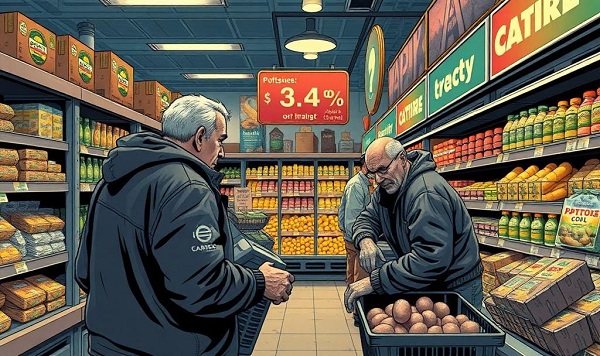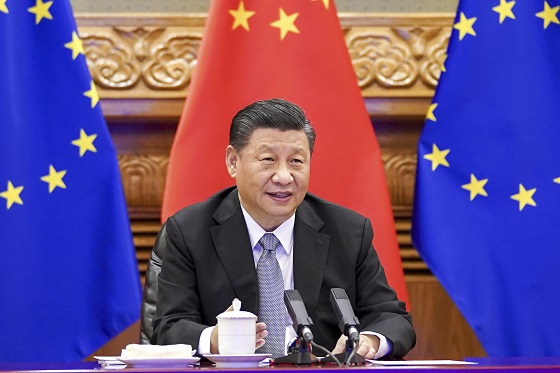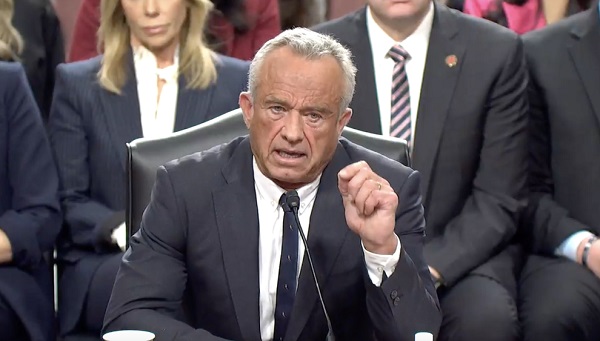Economy
When Potatoes Become a Luxury: Canada’s Grocery Gouging Can’t Continue

By Jeremy Nuttall
I don’t want to live in a country where pensioners have to put back potatoes, a food that supported millions of lives in desperate times
It was a routine wait in the grocery line last year when I personally witnessed the true cost of the grocery price spike. An elderly lady in front of me in the lineup did a double take when the clerk told her the total for her bill.
“What’s $10?” she asked, looking at the cashier’s screen. The clerk told her it was the handful of potatoes she’d grabbed. The woman, easily old enough to be retired, put the potatoes back.
Being middle-aged with a decent full-time job, until that moment, I was fortunate enough that experiencing the rising cost of groceries was not much more than a bit of a drag. But seeing a pensioner putting potatoes back highlighted the problem. The humble tuber has sustained whole civilizations in dire circumstances due to its being inexpensive and nourishing. Now it’s a luxury item?
After two years of complaints about the cost of groceries, the government pretending to fix the issue with the grocery code of conduct (and a lot of big talk), and more Canadians hitting food banks than at any time in recent memory, earlier this month we found out food prices will rise again next year.
The Food Price Report, produced by a joint effort between several Canadian universities, predicted a five per cent increase for meat and vegetables in 2025. That’s more than double the predicted rate of inflation from BMO for the coming 12 months.
Yet again, Canadian government actions have proven worthless.
The message is clear, and “we can’t really help you” is pretty much that message.
Another idea the government had to solve this was to head down to the U.S. to beg some of their chains to open up in Canada. This, rather than breaking up the big Canadian-owned grocery chains dominated by a couple of corporate giants already caught in a major price-fixing scandal, was their best idea.
Anything to get out of doing the work and angering the people with whom they hit the cocktail circuit.
I stopped buying my produce, and most of my meat, at large outlets a couple of years ago. I knew I was saving money, but just how much surprised me recently. I was at a Safeway and wanted to buy a russet potato there to save myself making another stop. I saw the price was $2.69 a pound. The spud I chose was more than a pound—potentially a $3 potato. Disgusted, I left the store without a thing to mash, bake, or julienne.
A few days later, I headed to my usual produce market, the Triple A market on Hastings in Burnaby, a trusty institution with a lot of character. I purchased a big russet potato, a big red onion, two Roma tomatoes, and two Ambrosia apples. (These are random items; please don’t try to make a pie out of this.)
My total was $5.15. This seemed reasonable to me. Right after, I went back to the same Safeway. I purchased the same items, while trying my best to get the weight as close as possible to the first batch I bought.
The result? Even with the Triple A red onion and potato having a couple hundred grams more weight, the Safeway total for the same basket was $8.83. That’s forty per cent more, probably closer to 50 per cent if you factor in the size difference for the onion and potato from Triple A.
A quick look around my nearest Jim Pattison-owned Buy-Low (or Buy Low Sell High, as we call it around my house) revealed prices similar to Safeway, yet the neighbourhood Sungiven, a Vancouver Asian market chain, had prices closer to those of the produce stand.
Now, the argument is often that big grocers have more overhead, advertising budgets, and larger staff. But I think it’s fair to say there’s something suspicious going on here. One thing is clear, though: big grocers are increasingly strictly for suckers.
Out here in B.C., this predicted five per cent increase in grocery prices will have companions by way of increases to property taxes recently passed in Metro Vancouver and a 17 per cent increase to natural gas rates in the province.
We may have a tariff war on the horizon, making all that even worse.
This crushing of Canadians can’t go on. Sadly, it will, due in part to the complete lack of real action from the authorities meant to protect the public interest.
To be clear, I’m not an expert on grocery stores or farming. I’m sure there are flaws in my complaints.
But one thing I know for certain is I don’t want to live in a country where pensioners have to put back potatoes—a food that has saved millions of lives during destitute times—at the checkout after seeing how much they cost.
And any government agency or elected official who thinks it can half-ass the response to something like that while collecting a paycheque is gouging Canadians in their own way.
The Bureau is a reader-supported publication. To receive new posts and support my work, consider becoming a free or paid subscriber.
Business
Is Government Inflation Reporting Accurate?


 David Clinton
David Clinton
Who ya gonna believe: official CPI figures or your lyin’ eyes?
Great news! We’ve brought inflation back under control and stuff is now only costing you 2.4 percent more than it did last year!
That’s more or less the message we’ve been hearing from governments over the past couple of years. And in fact, the official Statistics Canada consumer price index (CPI) numbers do show us that the “all-items” index in 2024 was only 2.4 percent higher than in 2023. Fantastic.
So why doesn’t it feel fantastic?
Well statistics are funny that way. When you’ve got lots of numbers, there are all kinds of ways to dress ‘em up before presenting them as an index (or chart). And there really is no one combination of adjustments and corrections that’s definitively “right”. So I’m sure Statistics Canada isn’t trying to misrepresent things.
But I’m also curious to test whether the CPI is truly representative of Canadians’ real financial experiences. My first attempt to create my own alternative “consumer price index”, involved Statistics Canada’s “Detailed household final consumption expenditure”. That table contains actual dollar figures for nation-wide spending on a wide range of consumer items. To represent the costs Canadian’s face when shopping for basics, I selected these nine categories:
- Food and non-alcoholic beverages
- Clothing and footwear
- Housing, water, electricity, gas and other fuels
- Major household appliances
- Pharmaceutical products and other medical products (except cannabis)
- Transport
- Communications
- University education
- Property insurance
I then took the fourth quarter (Q4) numbers for each of those categories for all the years between 2013 and 2024 and divided them by the total population of the country for each year. That gave me an accurate picture of per capita spending on core cost-of-living items.
Overall, living and breathing through Q4 2013 would have cost the average Canadian $4,356.38 (or $17,425.52 for a full year). Spending for those same categories in Q4 2024, however, cost us $6,266.48 – a 43.85 percent increase.
By contrast, the official CPI over those years rose only 31.03 percent. That’s quite the difference. Here’s how the year-over-year changes in CPI inflation vs actual spending inflation compare:
As you can see, with the exception of 2020 (when COVID left us with nothing to buy), the official inflation number was consistently and significantly lower than actual spending. And, in the case of 2021, it was more than double.
Since 2023, the items with the largest price growth were university education (57.46 percent), major household appliances (52.67 percent), and housing, water, electricity, gas, and other fuels (50.79).
Having said all that, you could justifiably argue that the true cost of living hasn’t really gone up that much, but that at least part of the increase in spending is due to a growing taste for luxury items and high volume consumption. I can’t put a precise number on that influence, but I suspect it’s not trivial.
Since data on spending doesn’t seem to be the best measure of inflation, perhaps I could build my own basket of costs and compare those numbers to the official CPI. To do that, I collected average monthly costs for gasoline, home rentals, a selection of 14 core grocery items, and taxes paid by the average Canadian homeowner.¹ I calculated the tax burden (federal, provincial, property, and consumption) using the average of the estimates of two AI models.
How did the inflation represented by my custom basket compare with the official CPI? Well between 2017 and 2024, the Statistics Canada’s CPI grew by 23.39 percent. Over that same time, the monthly cost of my basket grew from $4,514.74 to $5,665.18; a difference of 25.48 percent. That’s not nearly as dramatic a difference as we saw when we measured spending, but it’s not negligible either.
The very fact that the government makes all this data freely available to us is evidence that they’re not out to hide the truth. But it can’t hurt to keep an active and independent eye on them, too.
Subscribe to The Audit.
For the full experience, upgrade your subscription.
2025 Federal Election
Carney’s Hidden Climate Finance Agenda

From Energy Now
By Tammy Nemeth and Ron Wallace
It is high time that Canadians discuss and understand Mark Carney’s avowed plan to re-align capital with global Net Zero goals.
Mark Carney’s economic vision for Canada, one that spans energy, housing and defence, rests on an unspoken, largely undisclosed, linchpin: Climate Finance – one that promises a Net Zero future for Canada but which masks a radical economic overhaul.
Regrettably, Carney’s potential approach to a Net Zero future remains largely unexamined in this election. As the former chair of the Glasgow Financial Alliance for Net Zero (GFANZ), Carney has proposed new policies, offices, agencies, and bureaus required to achieve these goals.. Pieced together from his presentations, discussions, testimonies and book, Carney’s approach to climate finance appears to have four pillars: mandatory climate disclosures, mandatory transition plans, centralized data sharing via the United Nations’ Net Zero Data Public Utility (NZDPU) and compliance with voluntary carbon markets (VCMs). There are serious issues for Canada’s economy if these principles were to form the core values for policies under a potential Liberal government.
About the first pillar Carney has been unequivocal: “Achieving net zero requires a whole economy transition.” This would require a restructuring energy and financial systems to shift away from fossil fuels to renewable energy with Carney insisting repeatedly in his book that “every financial [and business] decision takes climate change into account.” Climate finance, unlike broader sustainable finance with its Environmental, Social, and Governance (ESG) focus would channel capital into sectors aligned with a 2050 Net Zero trajectory. Carney states: “Companies, and those who invest in them…who are part of the solution, will be rewarded. Those lagging behind…will be punished.” In other words, capital would flow to compliant firms but be withheld from so-called “high emitters”.
How will investors, banks and insurers distinguish solution from problem? Mandatory climate disclosures, aligned with the International Sustainability Standards Board (ISSB), would compel firms to report emissions and outline their Net Zero strategies. Canada’s Sustainability Standards Board has adopted these methodologies, despite concerns they would disadvantage Canadian businesses. Here, Carney repeatedly emphasizes disclosures as the cornerstone to track emissions data required to shift capital away from “high emitters”. Without this, he claims, large institutional investors lack the data on supply chains to make informed decisions to shift capital to businesses that are Net Zero compliant.
The second pillar, Mandatory Transition Plans would require companies to map a 2050 Net Zero trajectory for emission reduction targets. Failure to meet those targets would invite pressure from investors, banks, or activists, who may pursue litigation for non-compliance. The UK’s Transition Plan Task Force, now part of ISSB, provides this standardized framework. Carney, while at GFANZ, advocated using transition plans for a “managed phase-out” of high-emitting assets like coal, oil and gas, not just through divestment but by financing emissions reductions. “As part of their transition planning, [GFANZ] members should establish and apply financing policies to phase out and align carbon-intensive sectors and activities, such as thermal coal, oil and gas and deforestation, not only through asset divestment but also through transition finance that reduces real world emissions. To assist with these efforts GFANZ will continue to develop and implement a framework for the Managed Phase-out of high-emitting assets.” Clearly, the purpose of this is to ensure companies either decarbonize or face capital withdrawal.
The third pillar is the United Nations’ Net Zero Data Public Utility (NZDPU), a centralized platform for emissions and transition data. Carney insists these data be freely accessible, enabling investors, banks and insurers to judge companies’ progress to Net Zero. As Carney noted in 2021: “Private finance is judging…banks, pension funds and asset managers have to show where they are in the transition to Net Zero.” Hence, compliant firms would receive investment; laggards would face divestment.
Finally, voluntary carbon markets (VCMs) allow companies to offset emissions by purchasing credits from projects like reforestation. Carney, who launched the Taskforce on Scaling VCMs in 2020, has insisted on monitoring, verification and lifecycle tracking. At a 2024 Beijing conference, he suggested major jurisdictions could establish VCMs by COP 30 (planned for 2025 in Brazil) to create a global market. If Canada mandates VCMs, businesses especially small and medium enterprises (SMEs) would face much higher compliance costs with credits available only to those that demonstrate progress with transition plans.
These potential mandatory disclosures and transition plans would burden Canadian businesses with material costs and legal risks that constitute an economic gamble which few may recognize but all should weigh. Do Canadians truly want a government that has an undisclosed climate finance agenda that would be subservient to an opaque globalized Net Zero agenda?
Tammy Nemeth is a U.K.-based strategic energy analyst. Ron Wallace is an executive fellow of the Canadian Global Affairs Institute and the Canada West Foundation.
-

 Business2 days ago
Business2 days agoTrump: China’s tariffs to “come down substantially” after negotiations with Xi
-

 Business2 days ago
Business2 days agoTrump considers $5K bonus for moms to increase birthrate
-

 2025 Federal Election2 days ago
2025 Federal Election2 days agoPolice Associations Endorse Conservatives. Poilievre Will Shut Down Tent Cities
-

 Business1 day ago
Business1 day agoChinese firm unveils palm-based biometric ID payments, sparking fresh privacy concerns
-

 2025 Federal Election2 days ago
2025 Federal Election2 days agoCanada’s press tries to turn the gender debate into a non-issue, pretend it’s not happening
-

 COVID-192 days ago
COVID-192 days agoRFK Jr. Launches Long-Awaited Offensive Against COVID-19 mRNA Shots
-

 2025 Federal Election2 days ago
2025 Federal Election2 days agoNext federal government should end corporate welfare for forced EV transition
-

 2025 Federal Election1 day ago
2025 Federal Election1 day agoConservatives promise to ban firing of Canadian federal workers based on COVID jab status







